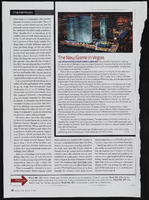Search the Special Collections and Archives Portal
Search Results
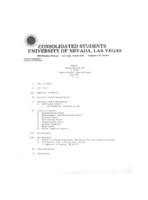
Meeting minutes for Consolidated Student Senate, University of Nevada, Las Vegas, January 06, 1981
Date
1981-01-06
Archival Collection
Description
Includes meeting agenda and minutes. CSUN Session 11 Meeting Minutes and Agendas.
Text
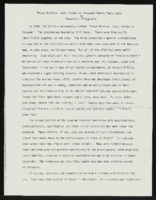
"Black History: Lost Stolen or Strayed -- Twenty Years Later": article draft by Roosevelt Fitzgerald
Date
1988 (year approximate)
Archival Collection
Description
From the Roosevelt Fitzgerald Professional Papers (MS-01082) -- Drafts for the Las Vegas Sentinel Voice file. On Black reality not significantly improved 20 years later.
Text
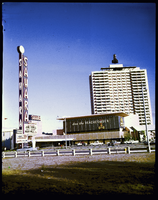
The Sahara Hotel and Casino, don the Beachcomber Restaurant, and the marquee: photographic film
Date
1960 (year approximate) to 1986 (year approximate)
Archival Collection
Description
An external view of the Sahara Hotel and Casino, don the Beachcomber Restaurant, and the marquee. The marquee advertises "Congo Room" "Stan Irvin Presents Jane Powell Dave Barry Maury Wills and singers" "B. [Buddy] Hackett & B [Buddy] Grecko" "Ceasar Theatre Music made famous by Glenn Miller" "Tex Beneke" "Ray Eberle" "The Modernaires with Paula Kelly" "Freddie Bell" and "Roberta Lynn". Taxi cabs are lined up waiting for fares. The Sahara Hotel and Casino (currently the SLS Hotel & Casino Las Vegas) was in operation for 59 years from 1952 to 2011. The hotel had 1,720 guestrooms and suites with a casino covering more than 85,000 square feet (7,900 m2). The first casino built on the site was Club Bingo, which opened in 1947. Owner Milton Prell replaced the casino with a new casino hotel in 1952 called the Sahara Hotel. Located just outside the City of Las Vegas, it was the sixth resort to open on the Strip. In 1961, the hotel was purchased by Del Webb. In 1962, a Don the Beachcomber restaurant opened in the hotel. The 24-story Alexandria Tower was added in 1963, which made the hotel the tallest building in Las Vegas. By 1978, the 27-story Tangiers Tower was added to the property. In 1999, further renovations added a roller coaster and a restaurant. The roller coaster, named "Speed - The Ride", shot riders from the hotel outside along the Las Vegas Strip, where it looped through the grandiose Sahara sign in front of the hotel, went straight up a tower, stopped and then took a return trip backwards. The Sahara shut down on May 16, 2011. The "Speed - The Ride", which was located in front of the casino, was sold and removed. It will be relocated across the Mandalay Bay in the new Akita Plaza. On February 14, 2013, Nazarian announced the groundbreaking for the $415 million conversion of the hotel into the SLS Las Vegas. The hotel opened on August 23, 2014. It contains 1,600 rooms, a casino, four nightclubs, the clothing store Fred Segal and various restaurants. The name "SLS" was chosen by Nazarian to denote style, luxury and service. The property is located at 2535 Las Vegas Blvd. South, Las Vegas, Nevada 89109.
Image
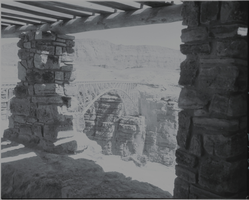
Film transparency of of the Navajo Bridge, Grand Canyon, Arizona, circa 1930s
Date
1930 to 1939
Archival Collection
Description
A view of the Navajo Bridge from inside an adjacent stone building, possibly the Old Cliff Dwellers Lodge (Blanche Russell Rock House), that was built circa 1920. Navajo Bridge crosses the Colorado River's Marble Canyon near Lee's Ferry in Arizona. It carries U.S. Route 89A. Spanning Marble Canyon, the bridge carries U.S. Route 89A northbound travelers to southern Utah and to the Arizona Strip, the otherwise inaccessible portion of Arizona north of the Colorado River, which includes the North Rim of Grand Canyon National Park. Prior to the construction of the first Navajo Bridge, the only river crossing from Arizona to Utah was at nearby Lee's Ferry, where the canyon walls are low and getting vehicles onto the water is relatively convenient. The ferry offered only unreliable service, however, as adverse weather and flooding regularly prevented its operation. Construction of the original Navajo Bridge began in 1927, and the bridge opened to traffic in 1929. The steel spandrel bridge design was constructed by the Kansas City Structural Steel Company. The bridge is 834 feet (254 m) in length, with a maximum height of 467 feet (142 m) from the canyon floor. Its roadway offers an 18-foot (5.5 m) surface width with a load capacity of 22.5 tons (although the posted legal weight limit was 40 tons). In 1990, however, it was decided that the traffic flow was too great for the original bridge, and that a new solution was needed. Deciding on a solution was difficult, due to the many local interests. Issues included preservation of sacred Navajo land, endangered plant species in Marble Canyon, and the possibility of construction pollution entering the river. A new steel arch bridge was commissioned by the Arizona Department of Transportation and the Federal Highway Administration, and was completed in September 1995, at a cost of approximately $15 million. The original Navajo Bridge is still open to pedestrian and equestrian use, and an interpretive center has been constructed nearby to showcase the historical nature of the bridge and early crossing of the Colorado River. Bungee jumpers are frequently seen using the span. The original bridge has been designated as a Historic Civil Engineering Landmark. The bridge was placed on the National Register of Historic Places on August 13, 1981.
Image
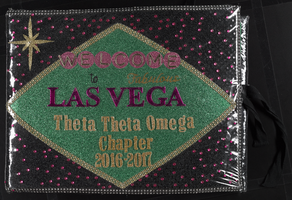
Alpha Kappa Alpha Sorority, Theta Theta Omega Chapter scrapbook: "Welcome to fabulous Las Vegas"
Date
2016 to 2017
Archival Collection
Description
From the Alpha Kappa Alpha Sorority, Incorporated, Theta Theta Omega Chapter Records (MS-01014).
Mixed Content
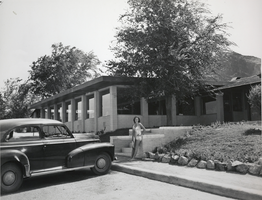
Photograph of a woman posing in front of the Lake Mead Lodge, Nevada, circa 1940s to 1950s
Date
1940 to 1959
Archival Collection
Description
A black and white image of a woman posing in front of the Lake Mead Lodge.
Image
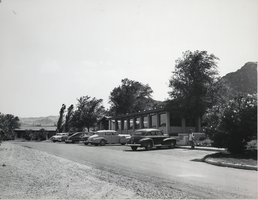
Photograph of the front exterior of the Lake Mead Lodge, Nevada, circa 1940s to 1950s
Date
1940 to 1959
Archival Collection
Description
A black and white image of the front exterior of the Lake Mead Lodge.
Image
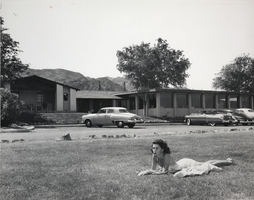
Photograph of the front entrance of the Lake Mead Lodge, Nevada, circa 1940s to 1950s
Date
1940 to 1959
Archival Collection
Description
A black and white image of a woman near the front entrance of the Lake Mead Lodge
Image
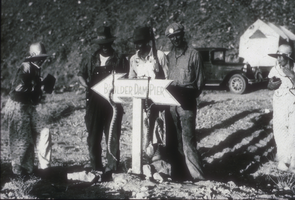
Slide of people at the Hoover Dam pier sign, April 18, 1931
Date
1931-04-18
Archival Collection
Description
A black and white image of people standing by the Boulder Dam Pier sign, which is draped with rattlesnakes. Note: Boulder Dam was officially renamed Hoover Dam in 1947.
Image
Pagination
Refine my results
Content Type
Creator or Contributor
Subject
Archival Collection
Digital Project
Resource Type
Year
Material Type
Place
Language
Records Classification

